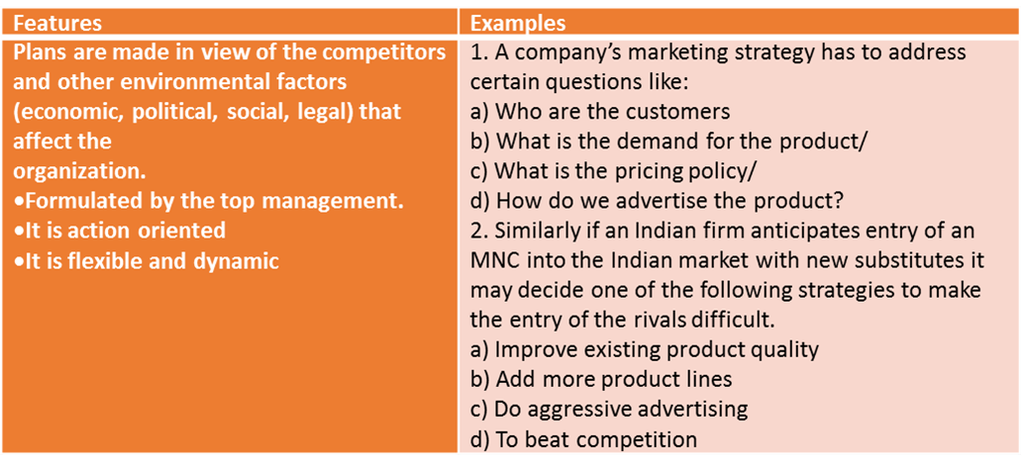- Books Name
- BUSINESS STUDIES-XII
- Publication
- ABCD CLASSES
- Course
- CBSE Class 12
- Subject
- Business Studies
TYPES OF PLANS
Single-Use Plan & Standing Plan
Single-use plan
- Single-use plans apply to activities that do not recur or repeat.
- Such Plan is developed to meet the needs of a unique situation.
- The length of a single-use plan differs greatly depending on the project in question, as a single event plan may only last one day while a single project may last weeks or months.
- Includes:- - Budget , Programs
Standing plans – known as repeat use plans
- Are used over and over again because they focus on organizational situations that occur repeatedly.
- Usually made once and retain their value over years
- That is why they are also called repeated use plans.
- Includes:- Policies, Procedures, Methods And Rules
Differences between standing and single-use plans

Objectives:
- Objectives are the ends towards which the physical & human energies of the enterprise are channelized.
- All individuals, groups, and depts. are integrated, coordinated and directed to achieve this end.
- Objectives can be major, minor, collateral. They are set by the top-level management.

Strategy:
- Strategy is a comprehensive plan for accomplishing an organization‘s objectives.
- This comprehensive plan will include (3 dimensions):
- Determining long term objectives
- Adopting a particular course of action
- Allocating resources necessary to achieve objectives

Policy:
- Organization general response to a particular problem/ situation.
- These are general statements/ understandings, which guide thinking & decision-making. A policy is an Organization's intention to act in certain ways when specific types of circumstances arise.
- Policies define the boundaries within which decisions can be made and they direct decisions towards the accomplishment of objectives.
Features
- The general response to a particular problem: guide managers in view of the repeated appearance of similar problems/situations
- Basis for objectives: Policies provide the routes to objectives.
- Provide guidelines for thinking/ action.
- Discretionary: provide scope for executive judgment.
- Top management‘s intention: generally formulated by top management. For operational purposes, managers at all levels also formulate their own policies
Examples: Recruitment policy, Pricing policy (for the elite segment); We don‘t sell on the credit's a policy of the sales dept.
PROCEDURE:
- A procedure is a series of related tasks that make up the chronological sequence & the established way of performing work to be accomplished.
- It gives a series of actions directed towards a goal.
- It specifies tasks to be performed /done sequentially for completing a piece of work
Features:
- Defines steps of doing different jobs/methods in routine. So it saves time.
- Helps to improve efficiency by providing standards and the best manner of doing work.
- Cuts across all dept. lines (e.g. execution of a sales order concerns sales, finance, production depts.)
- Help in the implementation of policies
Examples
Admission procedure, the Selection procedure for employees, Passport/Visa, Procedure for placing an order.
METHOD:
A method is a type of management plan that specifies the detailed and the best manner of performing a particular step, comprised in a procedure.
Features:
- Methods are formalized/-standardized ways of doing routine jobs
- These are standard ways of doing jobs, though there is no penalty for violation of methods
- These are defined to increase efficiency
- They are usually manual/ mechanical ways to perform an operation
Examples
- Depreciation methods: Straight line method, written down value method
- Methods of stocktaking: LIFO, FIFO, Training methods (e.g. orientation programs, lectures, etc.)
RULE:
- A rule requires that a specific action be taken for a situation.
- Rules are prescriptive directives to people in the org. and elsewhere to do or not to do things, to behave or not to behave in particular ways.
Features
- Rules indicate limits of acceptable behavior to the members of the org.
- They help to improve efficiency
- Help in maintaining discipline in the org.
Examples
•No smoking, No admission without permission
BUDGET:
A budget is a plan which states the expected results of a given future period in numerical terms. It may be expressed in time, money, or physical units.
Features:
- Presents the objectives of the enterprise in financial/Quantitative terms.
- Helps in financial control: provides standards by which actual performance can be measured.
- Coordinates activities of various depts. of a big enterprise by adjusting the departmental budgets into the master plan.
Since budgets specify measurable goals to be achieved within a specific period (usually one year), they inject a sense of clarity in directing and performing the activities of the org.
Examples -
Cash budget determines cash inflows and outflows, so that management knows how much cash it
should hold at all points of time for various purposes.
PROGRAMME:
- It is a comprehensive plan designed to implement the policies and accomplish objectives.
- It is a combination of goals, policies, task assignments, resource flows, etc.
- It is a concrete or well-designed scheme designed to accomplish a specific objective.
- It spells out the steps to be taken, resources to be used and the time taken to complete the task.
- It also indicates who should do what and how?
Features -
- Single-use abut comprehensive
- Action-based
- Result oriented
- Designed to ensure smooth and efficient functioning of the organization
- Great risk of failure due to changes in the environment
Example –
- Launching a new product.
- Training program.
- Advertising program.
- Expansion program.

 ABCD CLASSES
ABCD CLASSES
